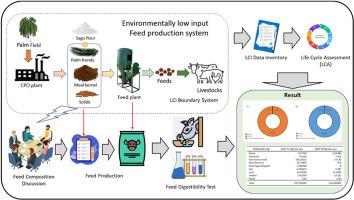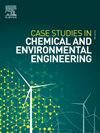棕榈油工业副产品对牲畜饲料的可持续利用:消化率和环境评价
Q1 Environmental Science
Case Studies in Chemical and Environmental Engineering
Pub Date : 2025-07-22
DOI:10.1016/j.cscee.2025.101263
引用次数: 0
摘要
棕榈油工业产生大量的副产品,具有替代牲畜饲料的潜力。本研究评估了两种饲料配方的消化率和环境影响:一种是由油棕叶、固体清液和棕榈仁饼组成的饲料配方,另一种是由油棕叶、棕榈仁饼和磨碎的西米组成的饲料配方。通过总收集法评估消化率,通过openLCA 2.0软件,采用CML-IA法与Ecoinvent 3.8数据库进行环境绩效评估。sago基饲料的消化率较高(65.71%),但饲料系数较低(16.81),这主要是由于干物质采食量增加,增加了总饲料消耗量,但没有造成体重成比例增加。相反,与西米饲料(197.243 kg CO2-eq/ton)相比,固体卧瓶饲料的饲料转化率(11.53)更好,但碳排放量(223.415 kg CO2-eq/ton)更高。在这两种饲料配方中,原料混合被确定为主要排放源,占温室气体排放总量的99%以上。这些发现强调了营养效率和可持续性之间的权衡,强调了使用低影响成分和改进加工以优化饲料生产的必要性。本文章由计算机程序翻译,如有差异,请以英文原文为准。

Sustainable utilization of palm oil industry by-products for livestock feed: A digestibility and environmental assessment
The palm oil industry generates substantial by-products with potential as alternative livestock feed. This study evaluated the digestibility and environmental impacts of two feed formulations: one combining oil palm fronds, solid decanter, and palm kernel cake, and another using oil palm fronds, palm kernel cake, and grated sago. Digestibility was assessed via the total collection method, while environmental performance was measured through openLCA 2.0 software, employing the CML-IA method with the Ecoinvent 3.8 database. The sago-based feed showed higher digestibility (65.71 %) but a poorer feed conversion ratio (16.81), primarily due to higher dry matter intake that increased overall feed consumption without a proportional gain in weight. Conversely, the solid decanter-based feed achieved better feed conversion ratio (11.53) but higher carbon emissions (223.415 kg CO2-eq/ton) compare with sago feed (197.243 kg CO2-eq/ton). In both feed formulations, feedstock mixing was identified as the dominant emission source, contributing over 99 % of total GHG emissions. These findings highlight trade-offs between nutritional efficiency and sustainability, emphasizing the need for low-impact ingredients and improved processing to optimize feed production.
求助全文
通过发布文献求助,成功后即可免费获取论文全文。
去求助
来源期刊

Case Studies in Chemical and Environmental Engineering
Engineering-Engineering (miscellaneous)
CiteScore
9.20
自引率
0.00%
发文量
103
审稿时长
40 days
 求助内容:
求助内容: 应助结果提醒方式:
应助结果提醒方式:


